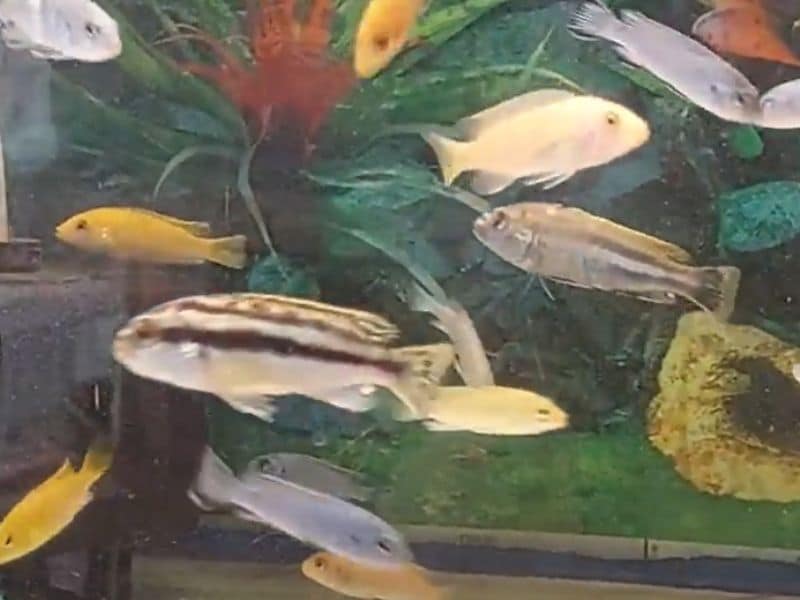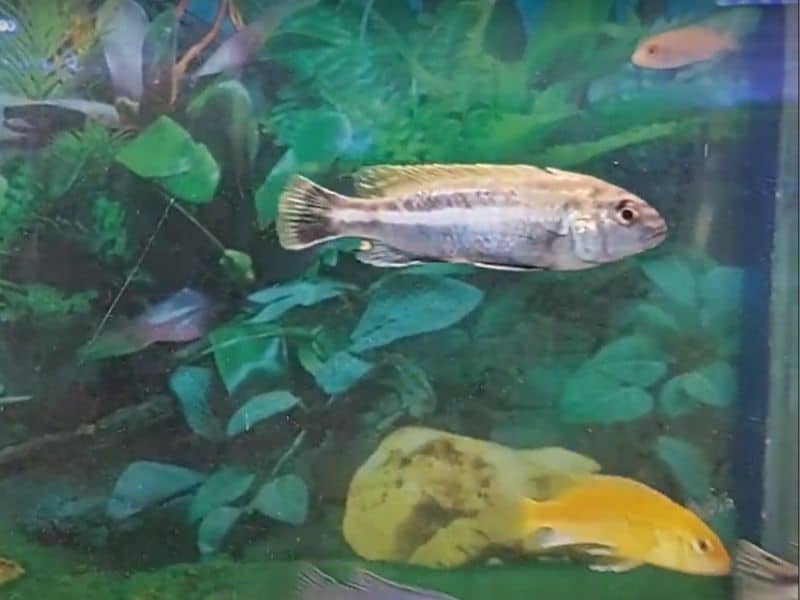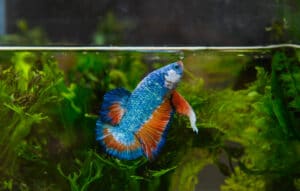A healthy Yellow Cichlid should have bright coloration, almost electrifyingly yellow. If you notice that your Yellow Cichlid is experiencing different colorations, such as black stripes, there is likely something wrong with the fish.
Why is my yellow cichlid turning black? There are two possible reasons for your yellow cichlid changing color. Either your fish has inherited bars genetically or it is stressed. More than likely, stress is to blame, and you need to fix the water’s parameters as a result.
To learn more about these two possible reasons your Yellow Cichlid is turning black, continue reading. We explain these two possible causes in further detail below and help you get your fish back to peak health.
Why Is My Yellow Cichlid Turning Black? 2 Possible Reasons
Paying attention to your Yellow Cichlid’s scales and colors is the number one way to determine its health. Any time you notice that your Yellow Cichlid’s color is changing, there is likely something wrong.
Ideally, Yellow Cichlids should be bright yellow. Most have a single black stripe that runs over the top of the fish’s fins.
Occasionally, some Yellow Cichlids will have more black bars on its body, but these black bars are inherited and should be on your fish from an early age.
If your Yellow Cichlid has only recently begun turning black, your fish is more than likely stressed. Stress is most often caused by poor tank parameters.
Even if you believe you are caring for your fish properly, double-check the tank parameters and fix the water accordingly.

Here is a closer look at the two possible reasons why your Yellow Cichlid is turning black:
1. Inherited Bars
If your Yellow Cichlid was born with additional black or black bars on its body, it most likely inherited the genes from its parents. This is not common in pure Yellow Cichlids. On the contrary, these pure fish should be primarily electric yellow.
Some breeders can mix Yellow Cichlids with other breeds, which causes black barring on the scales.
Whenever the black bars are inherited, this fish will have the bars at a young age. You won’t notice any other symptoms either.
The fish is perfectly happy and healthy, and its bars simply show the nature of its genes and mixed heritage.
2. Stress
Although it is possible for Yellow Cichlids to develop black bars genetically, it isn’t common.
Especially if your Yellow Cichlid is purely and responsibly bred, it should not have much black barring on it at all. Instead, barring is a sign that your fish is experiencing stress.
Whenever Cichlids experience stress, it is common for their coloration to change. This is not just a problem for Yellow Cichlids. When almost all Cichlids and fish are stressed, their scales and color will change according to their surroundings and situations.
A change in coloration is not the only sign that your fish is experiencing stress, though.
Its eating habits and activity will change as well. More specifically, swimming oddly, crashing at the bottom of the tank, rubbing on gravel, and failing to eat are all signs of stress in fish.
If your fish has these symptoms, stress is certainly to blame for its black barring.
What To Do If Your Yellow Cichlid Is Turning Black

If your Yellow Cichlid is turning black, it’s important to act quickly. Although you obviously can’t do anything about inherited black bars, stress will quickly become fatal if you do not rectify the issue.
It should be relatively obvious if your fish is turning black due to its genes or stress. If the fish is suddenly turning black and has never had any bars before, stress is to blame.
Once you determine that stress is to blame, which is the most likely cause, you need to clean the tank and perfect the parameters so that they are perfect for your fish’s needs. Until you fix the tank, it will continue to stress the fish out until it passes away.
How To Clean Your Fish Tank
The first step to helping your Yellow Cichlid is cleaning out the tank. Although it may be tempting to clean out the entire tank, it’s normally better to only clean out part of the tank at a time.
Instead, leave 50% of the water in the tank so that you clean out the tank as safely as possible. Keep that in mind while doing the following:
Begin by unplugging the heater, filter, and any other tools. Then, scrape off any algae. Next, go to the gravel and suction up any of the junk.
Try to keep about 50% of the water at all times in place. Once all of the obvious gunk is gone, fill in the rest of the tank with additional water.
If any of the decorations are visibly dirty, remove them from the tank and scrub them underneath running water. Replace them back into the fish tank carefully.
Throughout this cleaning process, do not use soap. Soap will kill your fish. Only use warm water and try to be as gentle as possible to avoid harming your fish.
Best Parameters For Your Yellow Cichlid
After you clean up the tank, you will need to make sure that the tank has the best parameters for the Yellow Cichlid.
These parameters include tank size, group size, and water conditions. Here are the parameters you need to set up for your Yellow Cichlid to be happy and healthy.
Tank Size
For starters, make sure that the tank is at least 40 gallons. Tanks that are long and short are best for this fish type. Any tank less than 40 gallons is too small for Yellow Cichlids. Although 40 gallons is the minimum size, the bigger, the better.
Group Size
Fish are not social in the way that humans are. Even so, it’s better to have a group of Yellow Cichlids so that they feel more comfortable in their home.
If you want to breed Yellow Cichlids, have a group of one male and two females. If you do not want to breed fish, go with two or three females, but do not get a male.
Water Conditions
The water itself needs to be between 75 and 82 degrees Fahrenheit with a pH of 7.5 to 8.5. Use a thermostat, heater, filter, and other tools to maintain these water conditions.
Check Up On Your Yellow Cichlid
Once you set up the best parameters for your Yellow Cichlid, your fish will get back to health, hopefully.
Be diligent in maintaining the fish’s parameters so that it can have the healthiest environment possible.
Even after your Yellow Cichlid is in the clear, maintain the parameters carefully. The last thing you want is to nourish your fish back to health only to force it back into the same dangerous parameters that caused the issue in the first place.
Keep in mind that this doesn’t always happen if you did not catch the problem early on enough.
Conclusion
If your Yellow Cichlid is turning black, it is most likely experiencing stress. Stress has many side effects on fish, one of which is a change in coloration. Occasionally, Yellow Cichlids can turn black due to genetics, but this is rare.
It’s best to assume that your Yellow Cichlid is turning black due to stress. As a result, clean out the tank and make sure the parameters are ideal for your Yellow Cichlid. Though it may be too late for the Yellow Cichlid, cleaning out the tank will create as safe an environment as possible and hopefully rectify the issue.
If you do these things, your Yellow Cichlid will get the help it needs. Remember, be gentle whenever cleaning out the tank, and keep a close eye on the fish afterward. Continue to maintain the proper parameters for your fish now and in the future, even if it gets better.
Recommend Reading: Why Parrot Fish Fight & How To Stop It?
Hi! I’m Praveen Ghoshal, the founder of eFishkeeping.com. Inspired by my Dad, I got interested in fishkeeping when I was a kid. Since then, I have been involved with this hobby. Currently, I have 3 fish tanks at our home, and I enjoy this hobby with my full family. Read more about me here.







